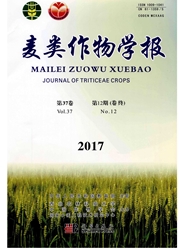

 中文摘要:
中文摘要:
为了探讨穗发芽相关基因Vp1B3不同等位变异在山东小麦中的分布与演变规律,利用Vp1B3的功能标记对山东小麦385份农家品种、101份历史品种和25份当前主栽品种进行鉴定。结果表明,Vp1B3的不同等位变异在不同历史时期的山东小麦中具有不同的分布特点:25份当前主栽品种中有17份含有抗穗发芽类型的等位变异(Vp1B3b、Vp1B3c),占68.0%;101份历史品种中抗穗发芽的类型有58份,占57.4%;而385份农家品种中只有100份属于抗穗发芽类型,仅占26.0%。在山东省四大麦区的地方品种中Vp1B3的等位基因分布规律亦不同:在胶东丘陵晚熟麦区及鲁西北平原冬性、半冬性、晚熟麦区的地方品种中抗穗发芽类型所占比例较小,分别为16.2%和9.9%;在鲁中山丘川半冬性、冬性中熟麦区和鲁西南平原湖洼半冬性早熟麦区的地方品种中抗穗发芽类型所占比例相对较大,分别为44.7%和37.8%。
 英文摘要:
英文摘要:
In order to understand the evolution of different Vp1B3 alleles in Shandong wheats, 385 landraces, 101 old varieties and 25 current varieties in different historical periods of Shandong province were characterized with the STS marker of Vp1B3. Among the 385 landraces, 100 was belong to tolerant genotype with Vp1B3b and Vp1B3c, accounting for 26.0%. While the tolerant varieties with Vp1B3b and Vp1B3c increased sharply in the old varieties, with the percentage of 57.4%, and 17 of the 25 current cultivars were with Vp1B3b and Vp1B3c, accounting for 68.0%. The frequency of Vp1B3 alleles also differed among the wheat ecological cultivation zones of Shandong. The frenquency of tolerance cultivars (Vp1B3b and Vp1B3c) was comparatively lower in the landraces from east Jiaolai river hill area and north-west plain area of Shandong, accounting for 16.2% and 9. 9%, respectively, while that from middle hill area and south-west plain and low-lying area was 44.7% and 37.8%, respectively.
 同期刊论文项目
同期刊论文项目
 同项目期刊论文
同项目期刊论文
 期刊信息
期刊信息
